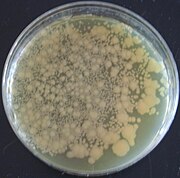Genetically modified organism
| Part of a series on |
| Genetic engineering |
|---|
 |
| Genetically modified organisms |
| History and regulation |
| Process |
| Applications |
| Controversies |
A genetically modified organism (GMO) is any
Genetic modification can include the introduction of new genes or enhancing, altering, or
Bacteria are the easiest organisms to engineer and have been used for research, food production, industrial protein purification (including drugs), agriculture, and art. There is potential to use them for environmental purposes or as medicine. Fungi have been engineered with much the same goals. Viruses play an important role as
Many objections have been raised over the development of GMOs, particularly their commercialization. Many of these involve GM crops and whether food produced from them is safe and what impact growing them will have on the environment. Other concerns are the objectivity and rigor of regulatory authorities, contamination of non-genetically modified food, control of the
Definition
The definition of a genetically modified organism (GMO) is not clear and varies widely between countries, international bodies, and other communities. At its broadest, the definition of a GMO can include anything that has had its genes altered, including by nature.
Another approach was the definition provided by the
Genetically engineered organism (GEO) can be considered a more precise term compared to GMO when describing organisms' genomes that have been directly manipulated with biotechnology.[16][8] The Cartagena Protocol on Biosafety used the synonym living modified organism (LMO) in 2000 and defined it as "any living organism that possesses a novel combination of genetic material obtained through the use of modern biotechnology."[17] Modern biotechnology is further defined as "In vitro nucleic acid techniques, including recombinant deoxyribonucleic acid (DNA) and direct injection of nucleic acid into cells or organelles, or fusion of cells beyond the taxonomic family."[18]
Originally, the term GMO was not commonly used by scientists to describe genetically engineered organisms until after usage of GMO became common in popular media.
The definitions focus on the process more than the product, which means there could be GMOS and non-GMOs with very similar genotypes and phenotypes.[21][22] This has led scientists to label it as a scientifically meaningless category,[23] saying that it is impossible to group all the different types of GMOs under one common definition.[24] It has also caused issues for organic institutions and groups looking to ban GMOs.[25][26] It also poses problems as new processes are developed. The current definitions came in before genome editing became popular and there is some confusion as to whether they are GMOs. The EU has adjudged that they are[27] changing their GMO definition to include "organisms obtained by mutagenesis", but has excluded them from regulation based on their "long safety record" and that they have been "conventionally been used in a number of applications".[9] In contrast the USDA has ruled that gene edited organisms are not considered GMOs.[28]
Even greater inconsistency and confusion is associated with various "Non-GMO" or "GMO-free" labeling schemes in food marketing, where even products such as water or salt, which do not contain any organic substances and genetic material (and thus cannot be genetically modified by definition), are being labeled to create an impression of being "more healthy".[29][30][31]
Production
Creating a genetically modified organism (GMO) is a multi-step process. Genetic engineers must isolate the gene they wish to insert into the host organism. This gene can be taken from a
A number of techniques are available for
As only a single cell is transformed with genetic material, the organism must be
Traditionally the new genetic material was inserted randomly within the host genome.
History

Humans have

In 1974,
In 1983, the first
In 1976,
The first
In 2010, scientists at the
The first genetically modified animal to be commercialized was the
Bacteria
Right: Bacteria transformed with pGLO visualized under ultraviolet light
Bacteria were the first organisms to be genetically modified in the laboratory, due to the relative ease of modifying their chromosomes.[88] This ease made them important tools for the creation of other GMOs. Genes and other genetic information from a wide range of organisms can be added to a plasmid and inserted into bacteria for storage and modification. Bacteria are cheap, easy to grow, clonal, multiply quickly and can be stored at −80 °C almost indefinitely. Once a gene is isolated it can be stored inside the bacteria, providing an unlimited supply for research.[89] A large number of custom plasmids make manipulating DNA extracted from bacteria relatively easy.[90]
Their ease of use has made them great tools for scientists looking to study gene function and
Bacteria have been used in the production of food for a long time, and specific strains have been developed and selected for that work on an
Genetically modified bacteria are used to produce large amounts of proteins for industrial use. The bacteria are generally grown to a large volume before the gene encoding the protein is activated. The bacteria are then harvested and the desired protein purified from them.
With a greater understanding of the role that the
For over a century, bacteria have been used in agriculture. Crops have been
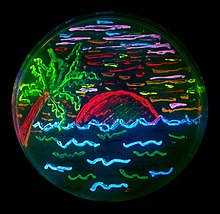
Other uses for genetically modified bacteria include bioremediation, where the bacteria are used to convert pollutants into a less toxic form. Genetic engineering can increase the levels of the enzymes used to degrade a toxin or to make the bacteria more stable under environmental conditions.[109] Bioart has also been created using genetically modified bacteria. In the 1980s artist Jon Davis and geneticist Dana Boyd converted the Germanic symbol for femininity (ᛉ) into binary code and then into a DNA sequence, which was then expressed in Escherichia coli.[110] This was taken a step further in 2012, when a whole book was encoded onto DNA.[111] Paintings have also been produced using bacteria transformed with fluorescent proteins.[110]
Viruses
Viruses are often modified so they can be used as vectors for inserting genetic information into other organisms. This process is called transduction and if successful the recipient of the introduced DNA becomes a GMO. Different viruses have different efficiencies and capabilities. Researchers can use this to control for various factors; including the target location, insert size, and duration of gene expression. Any dangerous sequences inherent in the virus must be removed, while those that allow the gene to be delivered effectively are retained.[112]
While viral vectors can be used to insert DNA into almost any organism it is especially relevant for its potential in treating human disease. Although primarily still at trial stages,
The most common virus used for gene delivery comes from
Most
Another potential use of genetically modified viruses is to alter them so they can directly treat diseases. This can be through expression of protective proteins or by directly targeting infected cells. In 2004, researchers reported that a genetically modified virus that exploits the selfish behavior of cancer cells might offer an alternative way of killing tumours.[122][123] Since then, several researchers have developed genetically modified oncolytic viruses that show promise as treatments for various types of cancer.[124][125][126][127][128] In 2017, researchers genetically modified a virus to express spinach defensin proteins. The virus was injected into orange trees to combat citrus greening disease that had reduced orange production by 70% since 2005.[129]
Natural viral diseases, such as myxomatosis and rabbit hemorrhagic disease, have been used to help control pest populations. Over time the surviving pests become resistant, leading researchers to look at alternative methods. Genetically modified viruses that make the target animals infertile through immunocontraception have been created in the laboratory[130] as well as others that target the developmental stage of the animal.[131] There are concerns with using this approach regarding virus containment[130] and cross species infection.[132] Sometimes the same virus can be modified for contrasting purposes. Genetic modification of the myxoma virus has been proposed to conserve European wild rabbits in the Iberian peninsula and to help regulate them in Australia. To protect the Iberian species from viral diseases, the myxoma virus was genetically modified to immunize the rabbits, while in Australia the same myxoma virus was genetically modified to lower fertility in the Australian rabbit population.[133]
Outside of biology scientists have used a genetically modified virus to construct a
Fungi
Fungi can be used for many of the same processes as bacteria. For industrial applications, yeasts combine the bacterial advantages of being a single-celled organism that is easy to manipulate and grow with the advanced protein modifications found in eukaryotes. They can be used to produce large complex molecules for use in food, pharmaceuticals, hormones, and steroids.[136] Yeast is important for wine production and as of 2016 two genetically modified yeasts involved in the fermentation of wine have been commercialized in the United States and Canada. One has increased malolactic fermentation efficiency, while the other prevents the production of dangerous ethyl carbamate compounds during fermentation.[96] There have also been advances in the production of biofuel from genetically modified fungi.[137]
Fungi, being the most common
Agaricus bisporus the common white button mushroom, has been gene edited to resist browning, giving it a longer shelf life. The process used CRISPR to knock out a gene that encodes polyphenol oxidase. As it didn't introduce any foreign DNA into the organism it was not deemed to be regulated under existing GMO frameworks and as such is the first CRISPR-edited organism to be approved for release.[142] This has intensified debates as to whether gene-edited organisms should be considered genetically modified organisms[143] and how they should be regulated.[144]
Plants
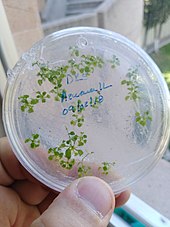
Plants have been engineered for scientific research, to display new flower colors, deliver vaccines, and to create enhanced crops. Many plants are
Much of the advances in the field of genetic engineering has come from experimentation with tobacco. Major advances in tissue culture and plant cellular mechanisms for a wide range of plants has originated from systems developed in tobacco.[146] It was the first plant to be altered using genetic engineering and is considered a model organism for not only genetic engineering, but a range of other fields.[147] As such the transgenic tools and procedures are well established making tobacco one of the easiest plants to transform.[148] Another major model organism relevant to genetic engineering is Arabidopsis thaliana. Its small genome and short life cycle makes it easy to manipulate and it contains many homologs to important crop species.[149] It was the first plant sequenced, has a host of online resources available and can be transformed by simply dipping a flower in a transformed Agrobacterium solution.[150]
In research, plants are engineered to help discover the functions of certain genes. The simplest way to do this is to remove the gene and see what

Some genetically modified plants are purely
It has been proposed to genetically modify some plant species threatened by extinction to be resistant to invasive plants and diseases, such as the emerald ash borer in North American and the fungal disease, Ceratocystis platani, in European plane trees.[158] The papaya ringspot virus devastated papaya trees in Hawaii in the twentieth century until transgenic papaya plants were given pathogen-derived resistance.[159] However, genetic modification for conservation in plants remains mainly speculative. A unique concern is that a transgenic species may no longer bear enough resemblance to the original species to truly claim that the original species is being conserved. Instead, the transgenic species may be genetically different enough to be considered a new species, thus diminishing the conservation worth of genetic modification.[158]
Crops
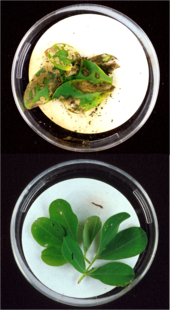
Genetically modified crops are genetically modified plants that are used in
There are three main aims to agricultural advancement; increased production, improved conditions for agricultural workers and sustainability. GM crops contribute by improving harvests through reducing insect pressure, increasing nutrient value and tolerating different abiotic stresses. Despite this potential, as of 2018, the commercialized crops are limited mostly to cash crops like cotton, soybean, maize and canola and the vast majority of the introduced traits provide either herbicide tolerance or insect resistance.[160] Soybeans accounted for half of all genetically modified crops planted in 2014.[161] Adoption by farmers has been rapid, between 1996 and 2013, the total surface area of land cultivated with GM crops increased by a factor of 100.[162] Geographically though the spread has been uneven, with strong growth in the Americas and parts of Asia and little in Europe and Africa.[160] Its socioeconomic spread has been more even, with approximately 54% of worldwide GM crops grown in developing countries in 2013.[162] Although doubts have been raised,[163] most studies have found growing GM crops to be beneficial to farmers through decreased pesticide use as well as increased crop yield and farm profit.[164][165][166]
The majority of GM crops have been modified to be resistant to selected herbicides, usually a
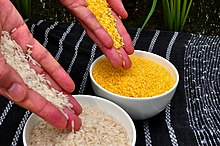
Plants and plant cells have been genetically engineered for production of
Vaccine production and storage has great potential in transgenic plants. Vaccines are expensive to produce, transport, and administer, so having a system that could produce them locally would allow greater access to poorer and developing areas.[181] As well as purifying vaccines expressed in plants it is also possible to produce edible vaccines in plants. Edible vaccines stimulate the immune system when ingested to protect against certain diseases. Being stored in plants reduces the long-term cost as they can be disseminated without the need for cold storage, don't need to be purified, and have long term stability. Also being housed within plant cells provides some protection from the gut acids upon digestion. However the cost of developing, regulating, and containing transgenic plants is high, leading to most current plant-based vaccine development being applied to veterinary medicine, where the controls are not as strict.[187]
Genetically modified crops have been proposed as one of the ways to reduce farming-related CO2 emissions due to higher yield, reduced use of pesticides, reduced use of tractor fuel and no tillage. According to a 2021 study, in EU alone widespread adoption of GE crops would reduce greenhouse gas emissions by 33 million tons of CO2 equivalent or 7.5% of total farming-related emissions.[188]
Animals
The vast majority of genetically modified animals are at the research stage with the number close to entering the market remaining small.[189] As of 2018 only three genetically modified animals have been approved, all in the USA. A goat and a chicken have been engineered to produce medicines and a salmon has increased its own growth.[190] Despite the differences and difficulties in modifying them, the end aims are much the same as for plants. GM animals are created for research purposes, production of industrial or therapeutic products, agricultural uses, or improving their health. There is also a market for creating genetically modified pets.[191]
Mammals
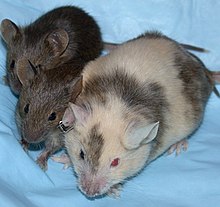
The process of genetically engineering mammals is slow, tedious, and expensive. However, new technologies are making genetic modifications easier and more precise.[192] The first transgenic mammals were produced by injecting viral DNA into embryos and then implanting the embryos in females.[60] The embryo would develop and it would be hoped that some of the genetic material would be incorporated into the reproductive cells. Then researchers would have to wait until the animal reached breeding age and then offspring would be screened for the presence of the gene in every cell. The development of the CRISPR-Cas9 gene editing system as a cheap and fast way of directly modifying germ cells, effectively halving the amount of time needed to develop genetically modified mammals.[193]
Mammals are the best models for human disease, making genetic engineered ones vital to the discovery and development of cures and treatments for many serious diseases. Knocking out genes responsible for
Human proteins expressed in mammals are more likely to be similar to their natural counterparts than those expressed in plants or microorganisms. Stable expression has been accomplished in sheep, pigs, rats and other animals. In 2009, the first human biological drug produced from such an animal, a
Livestock are modified with the intention of improving economically important traits such as growth-rate, quality of meat, milk composition, disease resistance and survival. Animals have been engineered to grow faster, be healthier
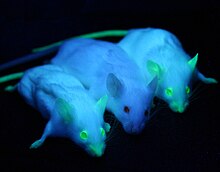
Scientists have genetically engineered several organisms, including some mammals, to include green fluorescent protein (GFP), for research purposes.[218] GFP and other similar reporting genes allow easy visualization and localization of the products of the genetic modification.[219] Fluorescent pigs have been bred to study human organ transplants, regenerating ocular photoreceptor cells, and other topics.[220] In 2011, green-fluorescent cats were created to help find therapies for HIV/AIDS and other diseases[221] as feline immunodeficiency virus is related to HIV.[222]
There have been suggestions that genetic engineering could be used to bring animals back from extinction. It involves changing the genome of a close living relative to resemble the extinct one and is currently being attempted with the passenger pigeon.[223] Genes associated with the woolly mammoth have been added to the genome of an African Elephant, although the lead researcher says he has no intention of creating live elephants and transferring all the genes and reversing years of genetic evolution is a long way from being feasible.[224][225] It is more likely that scientists could use this technology to conserve endangered animals by bringing back lost diversity or transferring evolved genetic advantages from adapted organisms to those that are struggling.[226]
Humans
In 2015, CRISPR was used to edit the DNA of non-viable
Fish
Genetically modified fish are used for scientific research, as pets and as a food source. Aquaculture is a growing industry, currently providing over half the consumed fish worldwide.[246] Through genetic engineering it is possible to increase growth rates, reduce food intake, remove allergenic properties, increase cold tolerance and provide disease resistance. Fish can also be used to detect aquatic pollution or function as bioreactors.[247]
Several groups have been developing zebrafish to detect pollution by attaching fluorescent proteins to genes activated by the presence of pollutants. The fish will then glow and can be used as environmental sensors.[248][249] The GloFish is a brand of genetically modified fluorescent zebrafish with bright red, green, and orange fluorescent color. It was originally developed by one of the groups to detect pollution, but is now part of the ornamental fish trade, becoming the first genetically modified animal to become publicly available as a pet when in 2003 it was introduced for sale in the USA.[250]
GM fish are widely used in basic research in genetics and development. Two species of fish, zebrafish and
GM fish have been developed with promoters driving an over-production of growth hormone for use in the aquaculture industry to increase the speed of development and potentially reduce fishing pressure on wild stocks. This has resulted in dramatic growth enhancement in several species, including salmon,[256] trout[257] and tilapia.[258] AquaBounty Technologies, a biotechnology company, have produced a salmon (called AquAdvantage salmon) that can mature in half the time as wild salmon.[259] It obtained regulatory approval in 2015, the first non-plant GMO food to be commercialized.[260] As of August 2017, GMO salmon is being sold in Canada.[261] Sales in the US started in May 2021.[262]
Insects
In biological research, transgenic fruit flies (
Due to their significance to human health, scientists are looking at ways to control mosquitoes through genetic engineering. Malaria-resistant mosquitoes have been developed in the laboratory by inserting a gene that reduces the development of the malaria parasite[268] and then use homing endonucleases to rapidly spread that gene throughout the male population (known as a gene drive).[269][270] This approach has been taken further by using the gene drive to spread a lethal gene.[271][272] In trials the populations of Aedes aegypti mosquitoes, the single most important carrier of dengue fever and Zika virus, were reduced by between 80% and by 90%.[273][274][272] Another approach is to use a sterile insect technique, whereby males genetically engineered to be sterile out compete viable males, to reduce population numbers.[275]
Other insect pests that make attractive targets are moths. Diamondback moths cause US$4 to $5 billion of damage each year worldwide.[276] The approach is similar to the sterile technique tested on mosquitoes, where males are transformed with a gene that prevents any females born from reaching maturity.[277] They underwent field trials in 2017.[276] Genetically modified moths have previously been released in field trials.[278] In this case a strain of pink bollworm that were sterilized with radiation were genetically engineered to express a red fluorescent protein making it easier for researchers to monitor them.[279]
Silkworm, the larvae stage of
Other
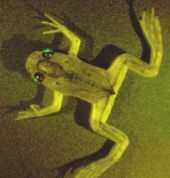
Systems have been developed to create transgenic organisms in a wide variety of other animals. Chickens have been genetically modified for a variety of purposes. This includes studying
The
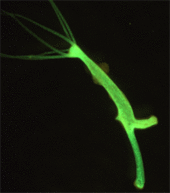
The gene responsible for
Regulation
Genetically modified organisms are regulated by government agencies. This applies to research as well as the release of genetically modified organisms, including crops and food. The development of a regulatory framework concerning genetic engineering began in 1975, at
Universities and research institutes generally have a special committee that is responsible for approving any experiments that involve genetic engineering. Many experiments also need permission from a national regulatory group or legislation. All staff must be trained in the use of GMOs and all laboratories must gain approval from their regulatory agency to work with GMOs.[313] The legislation covering GMOs are often derived from regulations and guidelines in place for the non-GMO version of the organism, although they are more severe.[314] There is a near-universal system for assessing the relative risks associated with GMOs and other agents to laboratory staff and the community. They are assigned to one of four risk categories based on their virulence, the severity of the disease, the mode of transmission, and the availability of preventive measures or treatments. There are four biosafety levels that a laboratory can fall into, ranging from level 1 (which is suitable for working with agents not associated with disease) to level 4 (working with life-threatening agents). Different countries use different nomenclature to describe the levels and can have different requirements for what can be done at each level.[314]


There are differences in the regulation for the release of GMOs between countries, with some of the most marked differences occurring between the US and Europe.[315] Regulation varies in a given country depending on the intended use of the products of the genetic engineering. For example, a crop not intended for food use is generally not reviewed by authorities responsible for food safety.[316] Some nations have banned the release of GMOs or restricted their use, and others permit them with widely differing degrees of regulation.[317][318][319][320] In 2016, thirty eight countries officially ban or prohibit the cultivation of GMOs and nine (Algeria, Bhutan, Kenya, Kyrgyzstan, Madagascar, Peru, Russia, Venezuela and Zimbabwe) ban their importation.[321] Most countries that do not allow GMO cultivation do permit research using GMOs.[322] Despite regulation, illegal releases have sometimes occurred, due to weakness of enforcement.[8]
The European Union (EU) differentiates between approval for cultivation within the EU and approval for import and processing.[323] While only a few GMOs have been approved for cultivation in the EU a number of GMOs have been approved for import and processing.[324] The cultivation of GMOs has triggered a debate about the market for GMOs in Europe.[325] Depending on the coexistence regulations, incentives for cultivation of GM crops differ.[326] The US policy does not focus on the process as much as other countries, looks at verifiable scientific risks and uses the concept of substantial equivalence.[327] Whether gene edited organisms should be regulated the same as genetically modified organism is debated. USA regulations sees them as separate and does not regulate them under the same conditions, while in Europe a GMO is any organism created using genetic engineering techniques.[28]
One of the key issues concerning regulators is whether GM products should be labeled. The
Controversy
There is controversy over GMOs, especially with regard to their release outside laboratory environments. The dispute involves consumers, producers, biotechnology companies, governmental regulators, non-governmental organizations, and scientists. Many of these concerns involve GM crops and whether food produced from them is safe and what impact growing them will have on the environment. These controversies have led to litigation, international trade disputes, and protests, and to restrictive regulation of commercial products in some countries.
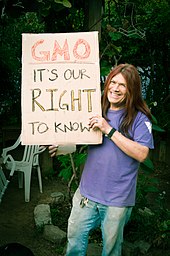
There is a scientific consensus[338][339][340][341] that currently available food derived from GM crops poses no greater risk to human health than conventional food,[342][343][344][345][346] but that each GM food needs to be tested on a case-by-case basis before introduction.[347][348][349] Nonetheless, members of the public are much less likely than scientists to perceive GM foods as safe.[350][351][352][353] The legal and regulatory status of GM foods varies by country, with some nations banning or restricting them, and others permitting them with widely differing degrees of regulation.[354][355][356][357]
As late as the 1990s
Other environmental and
Accusations that scientists are "playing God" and other religious issues have been ascribed to the technology from the beginning.[373] With the ability to genetically engineer humans now possible there are ethical concerns over how far this technology should go, or if it should be used at all.[374] Much debate revolves around where the line between treatment and enhancement is and whether the modifications should be inheritable.[375] Other concerns include contamination of the non-genetically modified food supply,[376][377] the rigor of the regulatory process,[378][379] consolidation of control of the food supply in companies that make and sell GMOs,[380] exaggeration of the benefits of genetic modification,[381] or concerns over the use of herbicides with glyphosate.[382] Other issues raised include the patenting of life[383] and the use of intellectual property rights.[384]
There are large differences in consumer acceptance of GMOs, with Europeans more likely to view GM food negatively than North Americans.[385] GMOs arrived on the scene as the public confidence in food safety, attributed to recent food scares such as Bovine spongiform encephalopathy and other scandals involving government regulation of products in Europe, was low.[386] This along with campaigns run by various non-governmental organizations (NGO) have been very successful in blocking or limiting the use of GM crops.[387] NGOs like the Organic Consumers Association, the Union of Concerned Scientists,[388][389][390] Greenpeace and other groups have said that risks have not been adequately identified and managed[391] and that there are unanswered questions regarding the potential long-term impact on human health from food derived from GMOs. They propose mandatory labeling[392][393] or a moratorium on such products.[380][378][394]
References
- ^ "Food, genetically modified". www.who.int. Retrieved 15 August 2023.
- PMID 31544299.
- ^ Chilton MD (4 October 2016). "Nature, The First Creator of GMOs". Forbes. Retrieved 4 January 2019.
- ^ Blakemore E. "The First GMO Is 8,000 Years Old". Smithsonian. Retrieved 5 January 2019.
- OCLC 27665641.
- ^ Staff Economic Impacts of Genetically Modified Crops on the Agri-Food Sector; p. 42 Glossary – Term and Definitions Archived 14 May 2013 at the Wayback Machine The European Commission Directorate-General for Agriculture, "Genetic engineering: The manipulation of an organism's genetic endowment by introducing or eliminating specific genes through modern molecular biology techniques. A broad definition of genetic engineering also includes selective breeding and other means of artificial selection", Retrieved 5 November 2012
- ^ The European Parliament and the council of the European Union (12 March 2001). "Directive on the release of genetically modified organisms (GMOs) Directive 2001/18/EC ANNEX I A". Official Journal of the European Communities.
- ^ a b c Freedman W (27 August 2018). "6 ~ Evolution". Environmental Science – a Canadian perspective (6 ed.). Dalhousie University.
- ^ a b "Organisms obtained by mutagenesis are GMOs and are, in principle, subject to the obligations laid down by the GMO Directive" (PDF). curia.europa.eu. Archived (PDF) from the original on 25 July 2018. Retrieved 5 January 2019.
- ^ "Section 2: Description and Definitions". www.fao.org. Retrieved 3 January 2019.
- ^ "Frequently asked questions on genetically modified foods". WHO. Retrieved 3 January 2019.
- ^ "The EU Legislation on GMOs – An Overview". EU Science Hub – European Commission. 29 June 2010. Retrieved 3 January 2019.
- ^ "GMOs and Horizontal Gene Transfer". NeuroLogica Blog. 13 October 2016. Retrieved 9 July 2021.
- .
- PMID 25665234.
- ^ Center for Food Safety and Applied Nutrition. "Food from Genetically Engineered Plants – Consumer Info About Food from Genetically Engineered Plants". www.fda.gov. Retrieved 8 January 2019.
- ^ Secretariat of the Convention on Biological Diversity. Montreal: 2000. The Cartagena Protocol on Biosafety to the Convention on Biological Diversity.
- ^ "Frequently Asked Questions (FAQs) on the Cartagena Protocol". The Biosafety Clearing-House (BCH). 29 February 2012. Retrieved 3 January 2019.
- ^ "What Is the Difference Between Genetically Modified Organisms and Genetically Engineered Organisms?". agbiotech.ces.ncsu.edu. Retrieved 8 January 2019.
- ^ "Agricultural Biotechnology Glossary | USDA". www.usda.gov. Retrieved 8 January 2019.
- ^ Colombo L (2007). "The semantics of the term 'genetically modified organism' // Genetic impact of aquaculture activities on native populations". Genimpact Final Scientific Report (E U Contract N. RICA-CT -2005-022802): 123–125.
- ISSN 0146-6283.
- ^ "Why the term GMO is 'scientifically meaningless'". Public Radio International. Retrieved 5 January 2019.
- S2CID 205281930.
- ^ "National Organic Standards Board Materials/GMO Subcommittee Second Discussion Document on Excluded Methods Terminology" (PDF). United States Department of Agriculture. 22 August 2014. Archived (PDF) from the original on 2 October 2015. Retrieved 4 January 2019.
- ^ "Here's Why You Should Vote Against Measure P, Even If You Hate GMOs". Lost Coast Outpost. Retrieved 4 January 2019.
- ISSN 0261-3077. Retrieved 5 January 2019.
- ^ PMID 29725105.
- ^ "Viewpoint: Non-GMO salt exploits Americans' scientific illiteracy". Genetic Literacy Project. 1 June 2018. Retrieved 9 July 2021.
- ^ Knutson J (28 May 2018). "A sad day for our society when salt is labeled non-GMO". Agweek. Retrieved 9 July 2021.
- ^ "Non GMO salt? Water? Food companies exploit GMO free labels, misleading customers, promoting misinformation". Genetic Literacy Project. 24 August 2015. Retrieved 9 July 2021.
- ISBN 978-1-139-47178-7.
- PMID 21064036.
- PMID 20061565.
- PMID 28261629.
- S2CID 205499369.
- ^ a b National Research Council (US) Committee on Identifying and Assessing Unintended Effects of Genetically Engineered Foods on Human Health (1 January 2004). Methods and Mechanisms for Genetic Manipulation of Plants, Animals, and Microorganisms. National Academies Press (US).
- PMID 12626681.
- ISBN 978-0-12-374106-6.
- S2CID 23000818.
- ISBN 978-0-07-460277-5.
- ISBN 978-0-306-47280-0.
- PMID 19584299.
- PMID 19811621.
- PMID 19404258.
- S2CID 4323298.
- PMID 20660643.
- PMID 20699274.
- PMID 23340847.
- PMID 23084873.
- ^ PMID 28451378.
- ISBN 978-0-226-43705-7.
- ^ Clive Root (2007). Domestication. Greenwood Publishing Groups.
- ^ Zohary D, Hopf M, Weiss E (2012). Domestication of Plants in the Old World: The Origin and Spread of Plants in the Old World. Oxford University Press.
- PMID 4342968.
- ISBN 978-81-906757-0-3. Retrieved 27 March 2013.
- .
- PMID 12540923.
- PMID 4600264.
- ^ PMID 4364530.
- ^ "'Any idiot can do it.' Genome editor CRISPR could put mutant mice in everyone's reach". Science | AAAS. 2 November 2016. Retrieved 2 December 2016.
- PMID 6272397.
- S2CID 4371351.
- PMID 17875663.
- S2CID 45925486.
- PMID 10819519.
- S2CID 3261903.
- S2CID 28713537.
- ISBN 978-0-12-384964-9.
- ^ S2CID 40258379.
- PMID 85300.
- ^ "Artificial Genes". Time. 15 November 1982. Archived from the original on 27 October 2011. Retrieved 17 July 2010.
- PMID 14997337.
- ^ BBC News 14 June 2002 GM crops: A bitter harvest?
- ^ Maugh, Thomas H. II (9 June 1987). "Altered Bacterium Does Its Job: Frost Failed to Damage Sprayed Test Crop, Company Says". Los Angeles Times.
- PMID 6308651.
- ^ James, Clive (1997). "Global Status of Transgenic Crops in 1997" (PDF). ISAAA Briefs No. 5.: 31. Archived (PDF) from the original on 16 January 2009.
- .
- ^ Debora MacKenzie (18 June 1994). "Transgenic tobacco is European first". New Scientist.
- ^ Genetically Altered Potato Ok'd For Crops Lawrence Journal-World. 6 May 1995
- ^ James C (1996). "Global Review of the Field Testing and Commercialization of Transgenic Plants: 1986 to 1995" (PDF). The International Service for the Acquisition of Agri-biotech Applications. Archived (PDF) from the original on 16 June 2010. Retrieved 17 July 2010.
- S2CID 7320517.
- ^ Sample I (20 May 2010). "Craig Venter creates synthetic life form". guardian.co.uk. London.
- PMID 22361646.
- ^ "Glowing fish to be first genetically changed pet". CNN. 21 November 2003. Retrieved 25 December 2018.
- ^ from the original on 2 January 2022. Retrieved 27 January 2019.
- ^ Bodnar A (October 2010). "Risk Assessment and Mitigation of AquAdvantage Salmon" (PDF). ISB News Report. Archived from the original (PDF) on 8 March 2021. Retrieved 22 January 2016.
- S2CID 24578435.
- ^ "Rediscovering Biology – Online Textbook: Unit 13 Genetically Modified Organisms". www.learner.org. Archived from the original on 3 December 2019. Retrieved 18 August 2017.
- S2CID 27404861.
- ^ Cooper GM (2000). "Cells As Experimental Models". The Cell: A Molecular Approach (2nd ed.).
- S2CID 49310760.
- PMID 23704788.
- ^ Pollack A (7 May 2014). "Researchers Report Breakthrough in Creating Artificial Genetic Code". The New York Times. Archived from the original on 2 January 2022. Retrieved 7 May 2014.
- PMID 24805238.
- ^ ISBN 978-0-12-384953-3.
- ISBN 978-93-80026-33-6
- ISBN 978-1-118-75641-6.
- ^ ISBN 978-1-60911-081-9.
- ^ S2CID 253769838.
- S2CID 3358528.
- S2CID 5986035.
- S2CID 2701961.
- PMID 17636758.
- PMID 17253498.
- ^ Summers, Rebecca (24 April 2013). "Bacteria churn out first ever petrol-like biofuel". New Scientist, Retrieved 27 April 2013
- PMID 29946090.
- PMID 12595134.
- PMID 29329004.
- ^ S2CID 259584956.
- PMID 22903519.
- PMID 24195604.
- ^ "Is gene therapy available to treat my disorder?". Genetics Home Reference. Retrieved 14 December 2018.
- ^ PMID 28396566.
- ^ PMID 29883422.
- ^ S2CID 5063701.
- ^ Manservigi R, Epstein AL, Argnani R, Marconi P (2013). HSV as a Vector in Vaccine Development and Gene Therapy. Landes Bioscience.
- S2CID 41198650.
- ^ PMID 28029542.
- PMID 23391465.
- PMID 24803000.
- ^ Bhattacharya S. "Genetically-modified virus explodes cancer cells". New Scientist.
- ^ Khamsi R. "GM virus shrinks cancer tumours in humans". New Scientist.
- S2CID 22520171.
- ^ Perett, Linda (30 June 2011) Measles viruses genetically modified to treat ovarian cancer National Cancer Institute, Benchmarks, Retrieved 5 September 2012
- PMID 21740365.
- ^ Beasley, Deena (31 August 2011) Cancer-fighting virus shown to target tumors alone Reuters Science, Retrieved 5 September 2012
- PMID 16507823.
- ^ Molteni M (12 April 2017). "Florida's Orange Trees Are Dying, But a Weaponized Virus Could Save Them". Wired. Retrieved 17 April 2017.
- ^ a b Jelley J (7 August 2002). "GM virus curbs rabbits". Retrieved 16 December 2018.
- ISSN 0261-3077. Retrieved 16 December 2018.
- ^ Mildura GO. "Virus could sterilise Australia's rabbits". New Scientist. Retrieved 16 December 2018.
- S2CID 23916432.
- PMID 27250768.
- S2CID 32017913.
- PMID 18349548.
- ^ "GM fungi: New way to produce cheap biofuel". The Times of India. 4 June 2013. Retrieved 17 December 2018.
- PMID 21350178.
- Francie Diep (28 February 2011). "Genetically altered fungus designed to attack malaria in mosquitoes". Scientific American.
- S2CID 255108053.
- ^ PMID 27131325.
- PMID 21474739.
- PMID 27111611.
- ^ Charles D (15 April 2016). "Will Genetically 'Edited' Food Be Regulated? The Case of the Mushroom". All Things Considered. National Public Radio. Retrieved 17 December 2018.
- ^ Zimmer C (27 July 2018). "What Is a Genetically Modified Crop? A European Ruling Sows Confusion". The New York Times. Archived from the original on 2 January 2022. Retrieved 17 December 2018.
- ^ a b c Walter P, Roberts K, Raff M, Lewis J, Johnson A, Alberts B (2002). "Studying Gene Expression and Function". Molecular Biology of the Cell (4th ed.). Garland Science.
- ^ Ganapathi TR, Suprasanna P, Rao PS, Bapat VA (2004). "Tobacco (Nicotiana tabacum L.) — A Model System for Tissue Culture Interventions and Genetic Engineering". Indian Journal of Biotechnology. 3: 171–184.
- PMID 18409340. Archived from the original(PDF) on 23 January 2013.
- ISBN 978-1-4200-9379-7.
- PMID 14536094.
- S2CID 253806270.
- PMID 3327686.
- ^ a b "Biotechnology in Ornamental Plants – Pocket K". www.isaaa.org. Retrieved 17 December 2018.
- PMID 22537268.
- ^ Nosowitz D (15 September 2011). "Suntory Creates Mythical Blue (Or, Um, Lavender-ish) Rose". Popular Science. Retrieved 30 August 2012.
- ^ "Suntory to sell blue roses overseas". The Japan Times. 11 September 2011. Archived from the original on 22 November 2012. Retrieved 30 August 2012.
- ^ "World's First 'Blue' Rose Soon Available in U.S". Wired. 14 September 2011.
- ^ Boehm (27 October 2009). "Green genetic engineering now conquers the ornamental plant market as well". Bioeconomy in Baden-Württemberg. Archived from the original on 3 April 2019. Retrieved 17 December 2018.
- ^ S2CID 86697592.
- PMID 17172756.
- ^ ISBN 978-1-137-40572-2.
- ^ a b "Global Status of Commercialized Biotech/GM Crops: 2014 – ISAAA Brief 49-2014". ISAAA.org. Retrieved 15 September 2016.
- ^ a b ISAAA 2013 Annual Report Executive Summary, Global Status of Commercialized Biotech/GM Crops: 2013 ISAAA Brief 46-2013, Retrieved 6 August 2014
- from the original on 2 January 2022. Retrieved 5 May 2017.
- S2CID 85891950.
- .
- PMID 25365303.
- PMID 23457026.
- PMID 24446395.
- ISBN 978-3-319-06891-6.
- ^ "SGK321". GM Approval Database. ISAAA.org. Retrieved 27 April 2017.
- PMID 18923484.
- ^ Frist B (21 November 2006). "'Green revolution' hero". The Washington Times.
One existing crop, genetically engineered 'golden rice' that produces vitamin A, already holds enormous promise for reducing blindness and dwarfism that result from a vitamin-A deficient diet.
- S2CID 3910132.
- PMID 1600583.
- S2CID 632005.
- ^ "US FDA approves GMO Golden Rice as safe to eat". Genetic Literacy Project. 29 May 2018. Retrieved 30 May 2018.
- ]
- ^ (10 December 2012) "Engineering algae to make complex anti-cancer 'designer' drug". PhysOrg, Retrieved 15 April 2013
- PMID 20723134.
- PMID 17129315.
- ^ ISBN 978-3-642-60234-4.
- PMID 20171137.
- PMID 19501503.
- ^ "UNL's AgBiosafety for Educators". agbiosafety.unl.edu. Retrieved 18 December 2018.
- ^ "ProCellEx® Platform". Protalix Biotherapeutics. Archived from the original on 27 October 2012.
- ^ Gali Weinreb and Koby Yeshayahou for Globes 2 May 2012. "FDA approves Protalix Gaucher treatment". Archived 29 May 2013 at the Wayback Machine
- PMID 28556800.
- bioRxiv 10.1101/2021.02.10.430488.
- ^ .
- ^ "The Superpowers of Genetically Modified Pigs". The Scientist. Retrieved 5 February 2019.
- ^ Rudinko, Larisa (20). Guidance for industry. USA: Center for veterinary medicine Link.
- ^ Murray, Joo (20). Genetically modified animals Archived 13 October 2019 at the Wayback Machine. Canada: Brainwaving
- ^ "How CRISPR is Spreading Through the Animal Kingdom". www.pbs.org. 23 May 2018. Retrieved 20 December 2018.
- ^ PMID 29419487.
- PMID 29203824.
- S2CID 4404433.
- PMID 19478771.
- PMID 19478751.
- ^ Britt Erickson, 10 February 2009, for Chemical & Engineering News. FDA Approves Drug From Transgenic Goat Milk Accessed 6 October 2012
- PMID 15888711.
- ^ Zimmer C (15 October 2015). "Editing of Pig DNA May Lead to More Organs for People l". The New York Times. Archived from the original on 2 January 2022.
- PMID 23780397.
- ^ "Pig Heart Transplants For Humans Could Be on Their Way". IFLScience. 30 April 2014.
- PMID 28129541.
- ^ "Man who received the second pig heart transplant dies, hospital says". www.nbcnews.com. Associated Press. 1 November 2023. Retrieved 1 November 2023.
- ^ Rabin, Roni Caryn (21 March 2024). "Surgeons Transplant Pig Kidney Into a Patient, a Medical Milestone". New York Times. Retrieved 22 March 2024.
- ^ Goodman, Brenda (21 March 2024). "Pig kidney transplanted into living person for first time". CNN. Retrieved 22 March 2024.
- PMID 16565727.
- ISSN 0261-3077. Retrieved 21 December 2018.
- ^ Zyga L (2010). "Scientist bred goats that produce spider silk". Phys.org. Archived from the original on 30 April 2015.
- ^ a b "Enviropig". Canada: University of Guelph. 2010. Archived from the original on 30 January 2016.
- ^ Schimdt S (22 June 2012). "Genetically engineered pigs killed after funding ends". Postmedia News. Retrieved 31 July 2012.
- ^ "Enviropig – Environmental Benefits". Canada: University of Guelph. Archived from the original on 27 February 2010. Retrieved 8 March 2010.
- ^ Gray R (2011). "Genetically modified cows produce 'human' milk". Archived from the original on 4 April 2011.
- ^ "Genetically modified cows producing human milk". Classical Medicine Journal. 14 April 2010. Archived from the original on 6 November 2014.
- ^ Yapp R (11 June 2011). "Scientists create cow that produces 'human' milk". The Daily Telegraph. London. Retrieved 15 June 2012.
- PMID 23027958.
- ^ "Green fluorescent protein takes Nobel prize". Lewis Brindley. Retrieved 31 May 2015.
- ^ Alberts B, Johnson A, Lewis J, Raff M, Roberts K, Walter P (2002). "Studying Gene Expression and Function". Molecular Biology of the Cell (4th ed.). Garland Science.
- PMID 21412358. Archived from the original (PDF) on 26 March 2014.)
{{cite journal}}: CS1 maint: DOI inactive as of April 2024 (link - PMID 21909101.
- ^ Staff (3 April 2012). "Biology of HIV". National Institute of Allergy and Infectious Diseases. Archived from the original on 11 April 2014.
- ^ Biello D. "Ancient DNA Could Return Passenger Pigeons to the Sky". Scientific American. Retrieved 23 December 2018.
- ^ Sarchet P. "Can we grow woolly mammoths in the lab? George Church hopes so". New Scientist. Retrieved 23 December 2018.
- ^ Hawks J (19 February 2017). "How mammoth cloning became fake news". John Hawks. Retrieved 20 January 2019.
- PMID 26530525.
- PMID 15466989.
- PMID 17549248.
- ^ Richards S (6 November 2012). "Gene therapy arrives in Europe". The Scientist.
- PMID 17078386.
- PMID 12901333.
- S2CID 37154043.
- ^ Gallaher, James (17 March 2011). "Gene therapy 'treats' Parkinson's disease". BBC News Health. Retrieved 24 April 2011
- ^ Urbina Z (12 February 2013). "Genetically Engineered Virus Fights Liver Cancer". United Academics. Archived from the original on 16 February 2013. Retrieved 15 February 2013.
- ^ "Treatment for Leukemia Is Showing Early Promise". The New York Times. Associated Press. 11 August 2011. p. A15. Retrieved 21 January 2013.
- ^ Coghlan A (26 March 2013). "Gene therapy cures leukaemia in eight days". New Scientist. Retrieved 15 April 2013.
- ^ "Gene therapy cures diabetic dogs". New Scientist. 13 February 2013. Retrieved 15 February 2013.
- ^ "New gene therapy trial gives hope to people with heart failure". British Heart Foundation. 30 April 2013. Retrieved 5 May 2013.
- PMID 17066097.
- ^ "1990 The Declaration of Inuyama". 5 August 2001. Archived from the original on 5 August 2001.
- PMID 23072719.
- ^ Kolata G (23 April 2015). "Chinese Scientists Edit Genes of Human Embryos, Raising Concerns". The New York Times. Archived from the original on 2 January 2022. Retrieved 24 April 2015.
- PMID 25894090.
- ^ Begley S (28 November 2018). "Amid uproar, Chinese scientist defends creating gene-edited babies – STAT". STAT.
- PMID 25058652.
- ^ "Half of Fish Consumed Globally Is Now Raised on Farms, Study Finds". ScienceDaily. Retrieved 21 December 2018.
- PMID 28602961.
- PMID 11813700.
- PMID 11564622.
- ^ Hallerman E (June 2004). "Glofish, the first GM animal commercialized: profits amid controversy". ISB News Report.
- ^ Hackett PB, Ekker SE, Essner JJ (2004). "Chapter 16: Applications of transposable elements in fish for transgenesis and functional genomics". In Gong Z, Korzh V (eds.). Fish Development and Genetics. World Scientific, Inc. pp. 532–80.
- doi:10.1002/cpet.19.
- PMID 28961226.
- PMID 25573382.
- PMID 17968670.
- S2CID 27048646.
- S2CID 5293883.
- .
- ^ Pollack A (21 December 2012). "Engineered Fish Moves a Step Closer to Approval". The New York Times. Archived from the original on 2 January 2022.
- ^ "FDA Has Determined That the AquAdvantage Salmon is as Safe to Eat as Non-GE Salmon". U.S. Food & Drug Administration. 19 November 2015. Retrieved 9 February 2018.
- ^ Waltz E. "First Genetically Engineered Salmon Sold in Canada". Scientific American. Retrieved 8 August 2017.
- ^ Smith, Casey (21 May 2021). "Genetically modified salmon head to US dinner plates". AP News. Retrieved 6 August 2021.
- PMID 18773074.
- ^ "Online Education Kit: 1981–82: First Transgenic Mice and Fruit Flies". genome.gov.
- PMID 28815502.
- .
- S2CID 255159948.
- PMID 20664791.
- ^ Gallagher J (20 April 2011). "GM mosquitoes offer malaria hope". BBC News, Health. Retrieved 22 April 2011.
- PMID 21508956.
- PMID 21383140.
- ^ a b Knapton S (6 February 2016). "Releasing millions of GM mosquitoes 'could solve zika crisis'". The Telegraph. Retrieved 14 March 2016.
- S2CID 30862975.
- ^ Staff (March 2011) "Cayman demonstrates RIDL potential". Oxitec Newsletter, March 2011. Retrieved 20 September 2011
- PMID 12901936.
- ^ a b Zhang S (8 September 2017). "Genetically Modified Moths Come to New York". The Atlantic. Retrieved 23 December 2018.
- ^ Scharping N (10 May 2017). "After Mosquitos, Moths Are the Next Target For Genetic Engineering". Discover. Archived from the original on 11 November 2019. Retrieved 23 December 2018.
- .
- PMID 21931649.
- PMID 26108630.
- S2CID 25310446.
- PMID 30082397.
- ^ Le Page M. "GM worms make a super-silk completely unknown in nature". New Scientist. Retrieved 23 December 2018.
- ^ "Poultry scientists develop transgenic chicken to aid study of embryo development". North Carolina State University. Retrieved 23 December 2018.
- ^ "Genetically modified chickens that don't transmit bird flu developed; Breakthrough could prevent future bird flu epidemics". ScienceDaily. Retrieved 23 December 2018.
- PMID 26888088.
- .
- PMID 17874805.
- ^ "Removing Threat from Invasive Species with Genetic Engineering?". Science in the News. 28 July 2014. Retrieved 23 December 2018.
- ^ "Cane toads to get the Crispr treatment". Radio National. 17 November 2017. Retrieved 23 December 2018.
- ^ "History of research on C. elegans and other free-living nematodes as model organisms". www.wormbook.org. Retrieved 24 December 2018.
- S2CID 85168270.
- PMID 25559107.
- ^ PMID 22118277.
- S2CID 254052063.
- PMID 26613986.
- PMID 29427110.
- PMID 29022701.
- ISBN 9789401039079. Retrieved 24 December 2018.
- ^ "More valuable than gold, but not for long: genetically-modified sea cucumbers headed to China's dinner tables". South China Morning Post. 5 August 2015. Retrieved 23 December 2018.
- PMID 29906446.
- "One special cell can revive a flatworm on the brink of death". Nature. 558 (7710): 346–347. 14 June 2018. S2CID 256768390.
- "One special cell can revive a flatworm on the brink of death". Nature. 558 (7710): 346–347. 14 June 2018.
- PMID 29242515.
- PMID 24807110.
- PMID 16556723.
- S2CID 36057310.
- PMID 25759636.
- .
- PMID 20855538.
- PMID 806076.
- ^ "About the Protocol". The Biosafety Clearing-House (BCH). 18 May 2021.
- ^ Redick TP (2007). "The Cartagena Protocol on biosafety: Precautionary priority in biotech crop approvals and containment of commodities shipments, 2007". Colorado Journal of International Environmental Law and Policy. 18: 51–116.
- ^ Kimani V, Gruère GP. "Implications of import regulations and information requirements under the Cartagena Protocol on biosafety for GM commodities in Kenya". AgBioForum. 13 (3): article 2. Archived from the original on 4 March 2016. Retrieved 18 February 2019.
- ISBN 978-3-527-33515-2.
- ^ PMID 18625678.
- PMID 10411496.
- ^ "The History and Future of GM Potatoes". PotatoPro.com. 11 December 2013. Archived from the original on 12 October 2013. Retrieved 27 September 2012.
- ^ "Restrictions on Genetically Modified Organisms". Library of Congress. 9 June 2015. Retrieved 24 February 2016.
- ^ Bashshur R (February 2013). "FDA and Regulation of GMOs". American Bar Association. Archived from the original on 29 September 2016. Retrieved 24 February 2016.
- ^ Sifferlin A (3 October 2015). "Over Half of E.U. Countries Are Opting Out of GMOs". Time.
- ^ Lynch D, Vogel D (5 April 2001). "The Regulation of GMOs in Europe and the United States: A Case-Study of Contemporary European Regulatory Politics". Council on Foreign Relations. Archived from the original on 29 September 2016. Retrieved 24 February 2016.
- ^ "Where are GMOs grown and banned?". GMO FAQ. 7 February 2016. Retrieved 11 February 2019.
- ^ "Restrictions on Genetically Modified Organisms – Law Library of Congress". Library of Congress. 22 January 2017.
- ^ Purnhagen K, Wesseler J (2016). "The 'Honey' Judgment of Bablok and Others Versus Freistaat Bayern in the Court of Justice of the European Union: Implications for Co-existence.". The coexistence of genetically modified, organic and conventional foods. New York, NY.: Springer. pp. 149–165.
- ^ Wesseler J, Purnhagen K. "Present and Future EU GMO policy". In Oskam A, Meesters G, Silvis H (eds.). EU Policy for Agriculture, Food and Rural Areas (2nd ed.). Wageningen: Wageningen Academic Publishers. pp. 23–332.
- ^ Wesseler J, Purnhagen K (2016). "Social, Economic and Legal Avenues". In Kalaitzandonakes N, et al. (eds.). The Coexistence of Genetically Modified, Organic and Conventional Foods. New York: Springer Science. pp. 71–85.
- ^ Beckmann V, Soregaroli C, Wesseler J (July 2011). "Chapter 8: Coexistence of Genetically Modified (GM) and Non-Modified (non-GM) crops: Are the Two Main Property Rights Regimes Equivalent with Respect to the Coexistence Value?". In Carter G, Moschini G, Sheldon I (eds.). Genetically modified food and global welfare. Frontiers of Economics and Globalization. Vol. 10. Bingley, UK: Emerald Group Publishing. pp. 201–224.
- ^ Emily Marden, Risk and Regulation: U.S. Regulatory Policy on Genetically Modified Food and Agriculture, 44 B.C.L. Rev. 733 (2003)[1]
- ^ "Regulation (EC) No 1829/2003 of the European Parliament and of the Council of 22 September 2003 On Genetically Modified Food And Feed" (PDF). Official Journal of the European Union L 268/3 (21). The European Parliament and the Council of the European Union. 2003. Archived from the original (PDF) on 20 January 2014.
The labeling should include objective information to the effect that a food or feed consists of, contains or is produced from GMOs. Clear labeling, irrespective of the detectability of DNA or protein resulting from the genetic modification in the final product, meets the demands expressed in numerous surveys by a large majority of consumers, facilitates informed choice, and precludes potential misleading of consumers as regards methods of manufacture or production.
- ^ "Regulation (EC) No 1830/2003 of the European Parliament and of the Council of 22 September 2003 concerning the traceability and labeling of genetically modified organisms and the traceability of food and feed products produced from genetically modified organisms and amending Directive 2001/18/EC". Official Journal L 268. The European Parliament and the Council of the European Union. 2003. pp. 24–28.
(3) Traceability requirements for GMOs should facilitate both the withdrawal of products where unforeseen adverse effects on human health, animal health or the environment, including ecosystems, are established, and the targeting of monitoring to examine potential effects on, in particular, the environment. Traceability should also facilitate the implementation of risk management measures in accordance with the precautionary principle. (4) Traceability requirements for food and feed produced from GMOs should be established to facilitate accurate labeling of such products.
- ^ "Report 2 of the Council on Science and Public Health: Labeling of Bioengineered Foods" (PDF). American Medical Association. 2012. Archived from the original (PDF) on 7 September 2012.
- ^ American Association for the Advancement of Science (AAAS), Board of Directors (2012). Statement by the AAAS Board of Directors On Labeling of Genetically Modified Foods, and associated Press release: Legally Mandating GM Food Labels Could Mislead and Falsely Alarm Consumers Archived 4 November 2013 at the Wayback Machine
- ^ Hallenbeck T (27 April 2014). "How GMO labeling came to pass in Vermont". Burlington Free Press. Retrieved 28 May 2014.
- ^ "The Regulation of Genetically Modified Foods". Archived from the original on 10 June 2017. Retrieved 25 December 2018.
- .
- ^ Smithsonian (2015). "Some Brands Are Labeling Products 'GMO-free' Even if They Don't Have Genes".
- .
- ^ "Q&A: genetically modified food". World Health Organization. Retrieved 7 May 2017.
- S2CID 9836802.
We have reviewed the scientific literature on GE crop safety for the last 10 years that catches the scientific consensus matured since GE plants became widely cultivated worldwide, and we can conclude that the scientific research conducted so far has not detected any significant hazard directly connected with the use of GM crops.
The literature about Biodiversity and the GE food/feed consumption has sometimes resulted in an animated debate regarding the suitability of the experimental designs, the choice of the statistical methods, or the public accessibility of data. Such debate, even if positive and part of the natural process of review by the scientific community, has frequently been distorted by the media and often used politically and inappropriately in anti-GE crops campaigns. - ^ "State of Food and Agriculture 2003–2004. Agricultural Biotechnology: Meeting the Needs of the Poor. Health and environmental impacts of transgenic crops". Food and Agriculture Organization of the United Nations. Retrieved 30 August 2019.
Currently available transgenic crops and foods derived from them have been judged safe to eat and the methods used to test their safety have been deemed appropriate. These conclusions represent the consensus of the scientific evidence surveyed by the ICSU (2003) and they are consistent with the views of the World Health Organization (WHO, 2002). These foods have been assessed for increased risks to human health by several national regulatory authorities (inter alia, Argentina, Brazil, Canada, China, the United Kingdom, and the United States) using their national food safety procedures (ICSU). To date, no verifiable untoward toxic or nutritionally deleterious effects resulting from the consumption of foods derived from genetically modified crops have been discovered anywhere in the world (GM Science Review Panel). Many millions of people have consumed foods derived from GM plants – mainly maize, soybean, and oilseed rape – without any observed adverse effects (ICSU).
- PMID 21546547.
There is broad scientific consensus that genetically engineered crops currently on the market are safe to eat. After 14 years of cultivation and a cumulative total of 2 billion acres planted, no adverse health or environmental effects have resulted from the commercialization of genetically engineered crops (Board on Agriculture and Natural Resources, Committee on Environmental Impacts Associated with Commercialization of Transgenic Plants, National Research Council and Division on Earth and Life Studies 2002). Both the U.S. National Research Council and the Joint Research Centre (the European Union's scientific and technical research laboratory and an integral part of the European Commission) have concluded that there is a comprehensive body of knowledge that adequately addresses the food safety issue of genetically engineered crops (Committee on Identifying and Assessing Unintended Effects of Genetically Engineered Foods on Human Health and National Research Council 2004; European Commission Joint Research Centre 2008). These and other recent reports conclude that the processes of genetic engineering and conventional breeding are no different in terms of unintended consequences to human health and the environment (European Commission Directorate-General for Research and Innovation 2010).
- ^ But see also:
- Domingo, José L.; Bordonaba, Jordi Giné (2011). "A literature review on the safety assessment of genetically modified plants" (PDF). Environment International. 37 (4): 734–742. (PDF) from the original on 31 August 2019.
I began this article with the testimonials from respected scientists that there is literally no scientific controversy over the health effects of GMOs. My investigation into the scientific literature tells another story.
And contrast:
- Panchin, Alexander Y.; Tuzhikov, Alexander I. (14 January 2016). "Published GMO studies find no evidence of harm when corrected for multiple comparisons". Critical Reviews in Biotechnology. 37 (2): 213–217. PMID 26536836.
It is therefore not surprising that efforts to require labeling and to ban GMOs have been a growing political issue in the USA (citing Domingo and Bordonaba, 2011). Overall, a broad scientific consensus holds that currently marketed GM food poses no greater risk than conventional food ... Major national and international science and medical associations have stated that no adverse human health effects related to GMO food have been reported or substantiated in peer-reviewed literature to date.
Despite various concerns, today, the American Association for the Advancement of Science, the World Health Organization, and many independent international science organizations agree that GMOs are just as safe as other foods. Compared with conventional breeding techniques, genetic engineering is far more precise and, in most cases, less likely to create an unexpected outcome.
- Domingo, José L.; Bordonaba, Jordi Giné (2011). "A literature review on the safety assessment of genetically modified plants" (PDF). Environment International. 37 (4): 734–742. (PDF) from the original on 31 August 2019.
- ^ "Statement by the AAAS Board of Directors on Labeling of Genetically Modified Foods" (PDF). American Association for the Advancement of Science. 20 October 2012. Retrieved 30 August 2019.
The EU, for example, has invested more than €300 million in research on the biosafety of GMOs. Its recent report states: 'The main conclusion to be drawn from the efforts of more than 130 research projects, covering a period of more than 25 years of research and involving more than 500 independent research groups, is that biotechnology, and in particular GMOs, are not per se riskier than e.g. conventional plant breeding technologies.' The World Health Organization, the American Medical Association, the U.S. National Academy of Sciences, the British Royal Society, and every other respected organization that has examined the evidence has come to the same conclusion: consuming foods containing ingredients derived from GM crops is no riskier than consuming the same foods containing ingredients from crop plants modified by conventional plant improvement techniques.
Pinholster, Ginger (25 October 2012). "AAAS Board of Directors: Legally Mandating GM Food Labels Could 'Mislead and Falsely Alarm Consumers'" (PDF). American Association for the Advancement of Science. Archived (PDF) from the original on 2 March 2014. Retrieved 30 August 2019. - ISBN 978-92-79-16344-9. Archived(PDF) from the original on 24 December 2010. Retrieved 30 August 2019.
- ^ "AMA Report on Genetically Modified Crops and Foods (online summary)". American Medical Association. January 2001. Retrieved 30 August 2019.
A report issued by the scientific council of the American Medical Association (AMA) says that no long-term health effects have been detected from the use of transgenic crops and genetically modified foods and that these foods are substantially equivalent to their conventional counterparts. ... Crops and foods produced using recombinant DNA techniques have been available for fewer than 10 years and no long-term effects have been detected to date. These foods are substantially equivalent to their conventional counterparts.
"Report 2 of the Council On Science and Public Health (A-12): Labeling of Bioengineered Foods" (PDF). American Medical Association. 2012. Archived from the original (PDF) on 7 September 2012. Retrieved 30 August 2019.Bioengineered foods have been consumed for close to 20 years, and during that time, no overt consequences on human health have been reported and/or substantiated in the peer-reviewed literature.
- ^ "Restrictions on Genetically Modified Organisms: United States. Public and Scholarly Opinion". Library of Congress. 30 June 2015. Retrieved 30 August 2019.
Several scientific organizations in the US have issued studies or statements regarding the safety of GMOs indicating that there is no evidence that GMOs present unique safety risks compared to conventionally bred products. These include the National Research Council, the American Association for the Advancement of Science, and the American Medical Association. Groups in the US opposed to GMOs include some environmental organizations, organic farming organizations, and consumer organizations. A substantial number of legal academics have criticized the US's approach to regulating GMOs.
- PMID 28230933. Retrieved 30 August 2019.)
Overall finding on purported adverse effects on human health of foods derived from GE crops: On the basis of a detailed examination of comparisons of currently commercialized GE with non-GE foods in compositional analysis, acute and chronic animal toxicity tests, long-term data on the health of livestock fed GE foods, and human epidemiological data, the committee found no differences that implicate a higher risk to human health from GE foods than from their non-GE counterparts.
{{cite book}}: CS1 maint: multiple names: authors list (link - ^ "Frequently asked questions on genetically modified foods". World Health Organization. Retrieved 30 August 2019.
Different GM organisms include different genes inserted in different ways. This means that individual GM foods and their safety should be assessed on a case-by-case basis and that it is not possible to make general statements on the safety of all GM foods.
GM foods currently available on the international market have passed safety assessments and are not likely to present risks for human health. In addition, no effects on human health have been shown as a result of the consumption of such foods by the general population in the countries where they have been approved. Continuous application of safety assessments based on the Codex Alimentarius principles and, where appropriate, adequate post-market monitoring, should form the basis for ensuring the safety of GM foods. - S2CID 2533628.
These principles dictate a case-by-case premarket assessment that includes an evaluation of both direct and unintended effects.
- ^ Some medical organizations, including the British Medical Association, advocate further caution based upon the precautionary principle:
"Genetically modified foods and health: a second interim statement" (PDF). British Medical Association. March 2004. Retrieved 30 August 2019.In our view, the potential for GM foods to cause harmful health effects is very small and many of the concerns expressed apply with equal vigour to conventionally derived foods. However, safety concerns cannot, as yet, be dismissed completely on the basis of information currently available.
When seeking to optimize the balance between benefits and risks, it is prudent to err on the side of caution and, above all, learn from accumulating knowledge and experience. Any new technology such as genetic modification must be examined for possible benefits and risks to human health and the environment. As with all novel foods, safety assessments in relation to GM foods must be made on a case-by-case basis.
Members of the GM jury project were briefed on various aspects of genetic modification by a diverse group of acknowledged experts in the relevant subjects. The GM jury reached the conclusion that the sale of GM foods currently available should be halted and the moratorium on commercial growth of GM crops should be continued. These conclusions were based on the precautionary principle and lack of evidence of any benefit. The Jury expressed concern over the impact of GM crops on farming, the environment, food safety and other potential health effects.
The Royal Society review (2002) concluded that the risks to human health associated with the use of specific viral DNA sequences in GM plants are negligible, and while calling for caution in the introduction of potential allergens into food crops, stressed the absence of evidence that commercially available GM foods cause clinical allergic manifestations. The BMA shares the view that there is no robust evidence to prove that GM foods are unsafe but we endorse the call for further research and surveillance to provide convincing evidence of safety and benefit. - ^ Funk, Cary; Rainie, Lee (29 January 2015). "Public and Scientists' Views on Science and Society". Pew Research Center. Retrieved 30 August 2019.
The largest differences between the public and the AAAS scientists are found in beliefs about the safety of eating genetically modified (GM) foods. Nearly nine-in-ten (88%) scientists say it is generally safe to eat GM foods compared with 37% of the general public, a difference of 51 percentage points.
- PMID 11463731.
- ^ Final Report of the PABE research project (December 2001). "Public Perceptions of Agricultural Biotechnologies in Europe". Commission of European Communities. Archived from the original on 25 May 2017. Retrieved 30 August 2019.
- (PDF) from the original on 25 March 2016.
- ^ "Restrictions on Genetically Modified Organisms". Library of Congress. 9 June 2015. Retrieved 30 August 2019.
- ^ Bashshur, Ramona (February 2013). "FDA and Regulation of GMOs". American Bar Association. Archived from the original on 21 June 2018. Retrieved 30 August 2019.
- ^ Sifferlin, Alexandra (3 October 2015). "Over Half of E.U. Countries Are Opting Out of GMOs". Time. Retrieved 30 August 2019.
- ^ Lynch, Diahanna; Vogel, David (5 April 2001). "The Regulation of GMOs in Europe and the United States: A Case-Study of Contemporary European Regulatory Politics". Council on Foreign Relations. Archived from the original on 29 September 2016. Retrieved 30 August 2019.
- ].
- S2CID 4417399.
- PMID 28163993.
- PMID 19005518.
- PMID 29187982.
- PMID 18801324.
- ^ "FDA: Genetically engineered fish would not harm nature". USA Today. 2012. Retrieved 28 November 2015.
- ^ Center for Veterinary Medicine. "Animals with Intentional Genomic Alterations – AquAdvantage Salmon Fact Sheet". www.fda.gov. Retrieved 6 February 2019.
- ^ "Containing Genetically Modified Bacteria". National Institutes of Health (NIH). 9 November 2015. Retrieved 12 September 2018.
- PMID 25185773.
- S2CID 9550338.
- S2CID 205278530.
- .
- ^ a b "Report in Brief – Genetically Engineered Crops" (PDF). National Academy of Sciences. Archived (PDF) from the original on 5 June 2018. Retrieved 14 February 2019.
- PMID 19727179.
- PMID 19816799.
- ^ Sparrow R, Cohen G (2015). "Genetically engineering humans: a step too far?". Pharmaceutical Journal. Archived from the original on 6 August 2020. Retrieved 14 February 2019.
- ^ Hamzelou J. "Human genome editing shouldn't be used for enhancement – yet". New Scientist. Retrieved 14 February 2019.
- ^ Chartered Institute of Environmental Health (2006) "Proposals for managing the coexistence of GM, conventional and organic crops Response to the Department for Environment, Food and Rural Affairs consultation paper" Archived 25 May 2017 at the Wayback Machine. October 2006
- .
- ^ a b Irish Doctors' Environmental Association "IDEA Position on Genetically Modified Foods". Archived 26 March 2014 at the Wayback Machine. Retrieved 25 March 2014.
- ^ American Medical Association (2012). "Report 2 of the Council on Science and Public Health: Labeling of Bioengineered Foods" Archived 7 September 2012 at the Wayback Machine. "To better detect potential harms of bioengineered foods, the Council believes that pre-market safety assessment should shift from a voluntary notification process to a mandatory requirement." p. 7
- ^ a b Canadian Association of Physicians for the Environment (2013) "Statement on Genetically Modified Organisms in the Environment and the Marketplace". Archived 26 March 2014 at the Wayback Machine. October 2013
- ^ "GMOs Are Safe, But Don't Always Deliver on Promises, Top Scientists Say". NPR.org. Retrieved 14 February 2019.
- S2CID 241739. Archived from the original(PDF) on 13 February 2021.
- PMID 11033718.
- ^ Zhou W (10 August 2015). "The Patent Landscape of Genetically Modified Organisms". Science in the News. Retrieved 5 May 2017.
- PMID 26264020.
- S2CID 157581205.
- PMID 25437241.
- ^ Johnson N (8 July 2013). "The genetically modified food debate: Where do we begin?". Grist.
- ^ Kloor K (22 August 2014). "On Double Standards and the Union of Concerned Scientists". Discover. Archived from the original on 20 November 2019. Retrieved 9 December 2014.
- ^ Marden E. "Risk and Regulation: U.S. Regulatory Policy on Genetically Modified Food and Agriculture". 44 B.C.L. Rev. 733 (2003).
By the late 1990s, public awareness of GM foods reached a critical level and a number of public interest groups emerged to focus on the issue. One of the early groups to focus on the issue was Mothers for Natural Law ('MFNL'), an Iowa based organization that aimed to ban GM foods from the market. ... The Union of Concerned Scientists ('UCS'), an alliance of 50,000 citizens and scientists, has been another prominent voice on the issue. ... As the pace of GM products entering the market increased in the 1990s, UCS became a vocal critic of what it saw as the agency's collusion with industry and failure to fully take account of allergenicity and other safety issues.
- ISBN 978-1-317-28081-1.
- ^ "Genetically modified food and health: A second interim statement" (PDF). British Medical Association Board of Science and Education. March 2004.
- ^ "Genetically Modified Foods" (PDF). Public Health Association of Australia. 2007. Archived from the original (PDF) on 20 January 2014.
- ^ PR Newswire "Genetically Modified Maize: Doctors' Chamber Warns of 'Unpredictable Results' to Humans". 11 November 2013

